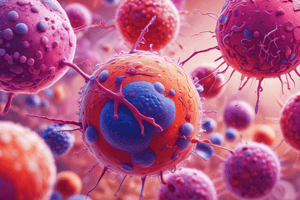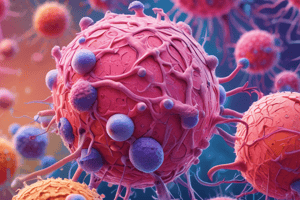Podcast
Questions and Answers
Which process ensures that T cells do not react against self-antigens, preventing autoimmunity?
Which process ensures that T cells do not react against self-antigens, preventing autoimmunity?
- Cytokine storm, activating innate immune responses
- Clonal expansion, increasing the number of antigen-specific T cells
- Positive selection, ensuring recognition of foreign antigens
- Negative selection, inducing apoptosis in autoreactive T cells (correct)
Where do T lymphocytes complete the final stages of their maturation process?
Where do T lymphocytes complete the final stages of their maturation process?
- Bone marrow
- Thymus (correct)
- Lymph nodes
- Spleen
Which of the following cell types is responsible for producing antibodies?
Which of the following cell types is responsible for producing antibodies?
- Dendritic cells
- B lymphocytes (correct)
- T lymphocytes
- Natural killer cells
Which of the following is a characteristic feature of lymphocytes?
Which of the following is a characteristic feature of lymphocytes?
What percentage range of total blood lymphocytes do B lymphocytes typically represent?
What percentage range of total blood lymphocytes do B lymphocytes typically represent?
Which of the following markers is commonly found on B lymphocytes?
Which of the following markers is commonly found on B lymphocytes?
Which of the following best describes the function of the B cell receptor (BCR)?
Which of the following best describes the function of the B cell receptor (BCR)?
If a patient's blood work indicates a decreased number of NK cells, what condition might this suggest they are more susceptible to?
If a patient's blood work indicates a decreased number of NK cells, what condition might this suggest they are more susceptible to?
What is the primary role of T regulatory cells (Treg)?
What is the primary role of T regulatory cells (Treg)?
Which of the following is the key function of cytotoxic T cells (CD8+)?
Which of the following is the key function of cytotoxic T cells (CD8+)?
Which type of T cell is crucial for activating B lymphocytes to produce antibodies?
Which type of T cell is crucial for activating B lymphocytes to produce antibodies?
Which of the following statements accurately describes how T lymphocytes recognize antigens?
Which of the following statements accurately describes how T lymphocytes recognize antigens?
What is the significance of MHC restriction in T cell activation?
What is the significance of MHC restriction in T cell activation?
What is the role of Killer Inhibitory Receptors (KIRs) on NK cells?
What is the role of Killer Inhibitory Receptors (KIRs) on NK cells?
Which of the following is a primary function of Natural Killer (NK) cells?
Which of the following is a primary function of Natural Killer (NK) cells?
What is Antibody-Dependent Cellular Cytotoxicity (ADCC)?
What is Antibody-Dependent Cellular Cytotoxicity (ADCC)?
Which of the following cell types is part of the innate immune system?
Which of the following cell types is part of the innate immune system?
In the context of the immune system, what does 'hematopoiesis' refer to?
In the context of the immune system, what does 'hematopoiesis' refer to?
Which of the following is an example of a primary lymphoid organ?
Which of the following is an example of a primary lymphoid organ?
What is the main function of secondary lymphoid organs?
What is the main function of secondary lymphoid organs?
Which surface marker is commonly associated with helper T cells?
Which surface marker is commonly associated with helper T cells?
What is a key characteristic of innate immunity compared to adaptive immunity?
What is a key characteristic of innate immunity compared to adaptive immunity?
Following their maturation, where do naïve lymphocytes typically migrate to?
Following their maturation, where do naïve lymphocytes typically migrate to?
Which of the following best illustrates the adaptive immune system?
Which of the following best illustrates the adaptive immune system?
Which of the following cells originate from a common myeloid progenitor?
Which of the following cells originate from a common myeloid progenitor?
Which of the following is a key feature of T cell receptors (TCRs)?
Which of the following is a key feature of T cell receptors (TCRs)?
The bone marrow serves as the primary site for the maturation of which type of lymphocyte?
The bone marrow serves as the primary site for the maturation of which type of lymphocyte?
How do NK cells recognize abnormal host cells?
How do NK cells recognize abnormal host cells?
What is the typical outcome of positive selection in the thymus?
What is the typical outcome of positive selection in the thymus?
Flashcards
Innate Immunity
Innate Immunity
The body's initial, non-specific defense mechanisms against pathogens.
Adaptive Immunity
Adaptive Immunity
A specific defense mechanism that adapts to recognize and eliminate pathogens; has immunological memory.
Lymphoid Progenitor
Lymphoid Progenitor
Cells derived from hematopoietic stem cells in bone marrow; includes T cells, B cells and NK cells.
Myeloid Progenitor
Myeloid Progenitor
Signup and view all the flashcards
Primary Lymphoid Organs
Primary Lymphoid Organs
Signup and view all the flashcards
Secondary Lymphoid Organs
Secondary Lymphoid Organs
Signup and view all the flashcards
Lymphocytes
Lymphocytes
Signup and view all the flashcards
B Lymphocytes
B Lymphocytes
Signup and view all the flashcards
B Cell Phenotype Markers
B Cell Phenotype Markers
Signup and view all the flashcards
B Cell Function
B Cell Function
Signup and view all the flashcards
T Lymphocytes
T Lymphocytes
Signup and view all the flashcards
T Cell Phenotype Markers
T Cell Phenotype Markers
Signup and view all the flashcards
T Cell Function
T Cell Function
Signup and view all the flashcards
Helper T Cells (CD4+)
Helper T Cells (CD4+)
Signup and view all the flashcards
Cytotoxic T Cells (CD8+)
Cytotoxic T Cells (CD8+)
Signup and view all the flashcards
Regulatory T Cells (T reg)
Regulatory T Cells (T reg)
Signup and view all the flashcards
TCR
TCR
Signup and view all the flashcards
Antigen Recognition By T Cells
Antigen Recognition By T Cells
Signup and view all the flashcards
Natural Killer (NK) Cells
Natural Killer (NK) Cells
Signup and view all the flashcards
Killer Activation Receptors (KARs)
Killer Activation Receptors (KARs)
Signup and view all the flashcards
Killer Inhibitory Receptors (KIRs)
Killer Inhibitory Receptors (KIRs)
Signup and view all the flashcards
ADCC
ADCC
Signup and view all the flashcards
Study Notes
Cells of the Immune System
- The immune system has two lines of defense: innate (non-specific) immunity and adaptive (Specific) immunity.
- All immune system cells originate from a hematopoietic stem cell in the bone marrow.
- Hematopoietic stem cells give rise to a common lymphoid progenitor and a common myeloid progenitor.
- The common lymphoid progenitor gives rise to T lymphocytes, B lymphocytes, and natural killer (NK) cells.
- The common myeloid progenitor gives rise to leukocytes, erythrocytes, and platelets.
- Leukocytes include neutrophils, eosinophils, basophils, monocytes, mast cells, and dendritic cells.
Lymphoid Tissues and Organs
- Lymphoid tissues and organs are where lymphocytes develop and function.
- Primary lymphoid organs are the site of maturation of lymphocytes and include the bone marrow and thymus.
- Lymphocytes are released as naïve (virgin) and mature into the blood.
- Secondary lymphoid organs include the lymph nodes, spleen, tonsils, and Peyer's patches.
- Lymphocytes that have not previously encountered antigen (naive) reach the secondary lymphoid organs via blood and lymphatic vessels, where they recognize antigen and initiate the immune response.
Bone Marrow (BM)
- Bone marrow (BM) is the site of B cell maturation and generation of all blood cells from a common stem cell (hematopoiesis).
Thymus
- The thymus is the site of T cell maturation.
- T cells learn how to discriminate between self and non-self antigens undergo selection processes in the thymus.
- Positive selection ensures T cells can recognize and bind to self MHC or peptide + MHC molecules.
- Negative selection eliminates autoreactive T cells, which recognize self-peptides efficiently and could harm the host.
- T cells that pass both positive and negative selection tests "graduate" from the thymus and enter circulation as mature, naïve T cells.
Lymphocytes
- Lymphocytes arise from stem cells in the bone marrow and develop into B cells or T cells, depending on where they continue their maturation..
- Lymphocytes are the only cells with specific receptors for antigens and are the mediators of adaptive immunity.
- Lymphocytes can be distinguished by surface proteins called "CD" (cluster of differentiation) and a number (e.g., CD1, CD2, CD3, CD4, CD8, CD16).
- Lymphocytes include B lymphocytes (mediators of humoral immunity), T lymphocytes (mediators of cell-mediated immunity), and natural killer cells (cells of innate immunity).
B Lymphocytes
- B lymphocytes are bone marrow-derived lymphocytes that develop and mature in the bone marrow.
- B lymphocytes develop from stem cells to pre-B cells to immature B cells to mature and naive B cells, which leave the bone marrow to meet antigens in secondary lymphoid tissues.
- B lymphocytes represent 10-15% of total blood lymphocytes
- Phenotype markers include surface immunoglobulins, CD19, CD21, class II MHC, and Fc receptors.
- B lymphocytes are for antibody (Ab) production (humoral immunity).
- B lymphocytes can recognize a wide variety of antigens (Ag), including proteins, polysaccharides, and lipids via Ag specific receptor called B cell receptor (BCR).
- B lymphocytes are stimulated by antigen to proliferate and differentiate into plasma cells, which secrete antibodies to eliminate Ag, and memory B cells.
T Lymphocytes
- T lymphocytes are thymus-derived lymphocytes that develop and mature in the thymus and represent the majority of blood lymphocytes.
- Phenotype markers include TCR, CD3, CD4, and CD8.
- T lymphocytes mediate cell-mediated immunity.
- Two subsets are present according to the presence of either CD4 or CD8 marker or another regulatory cell.
- Helper T cells (CD4+) are called helper cells because they help other cells through the secretion of helper factors, i.e., cytokines.
- They help B lymphocytes to produce antibodies.
- They help macrophage activation to destroy ingested microbes.
- Subsets: Th1 & Th2 according to cytokine profile.
- Cytotoxic or cytolytic T cells (CD8+) are called cytolytic because they lyse target cells via killing virus-infected cells, killing tumor cells, and rejection of allografts.
- T regulatory cells (T reg) suppress the immune response.
- T lymphocytes recognize protein antigens only via antigen specific receptors, called TCR.
- TCR consists of 2 polypeptide chains are called α and β.
- T lymphocytes do not recognize antigens directly (unlike B lymphocytes).
- T lymphocytes only recognize antigens in the form of peptide fragments of protein antigens (peptide = processed antigen) plus MHC molecules on the surface of antigen presenting cells (APCs), which is called MHC restriction.
- CD4+ cells recognize peptide + class II MHC molecules.
- CD8+ cells recognize peptide + class I MHC molecules.
Natural Killer (NK) cells:
- Natural killer (NK) cells are a third population of lymphocytes.
- NK cells are large lymphocytes with numerous cytoplasmic granules and comprise about 10% of blood lymphocytes.
- NK cells do not express either BCR nor TCR
- Phenotype markers: CD16, Fc receptor for IgG.
- NK cells detect abnormal host cells and target them for destruction.
- NK cell receptors include:
- Killer activation receptors (KARs) recognize stress molecules on the surface of the target cell (infected and transformed cells). Binding of KAR to stress molecules generates a kill signal (+).
- Killer inhibitory receptors (KIRs) assess MHC I molecules on the target cell surface before killing. Sufficient binding of KIRs to MHC І generates an inhibitory signal (-) that overrides the KAR kill signal, inhibiting killing and allowing the cell to survive.
- NK cells are activated by IL-12 to perform these functions:
- Killing tumor cells.
- Killing virus-infected cells.
- Produce IFN-γ, activating macrophages.
- Antibody-dependent cellular cytotoxicity (ADCC).
Studying That Suits You
Use AI to generate personalized quizzes and flashcards to suit your learning preferences.




